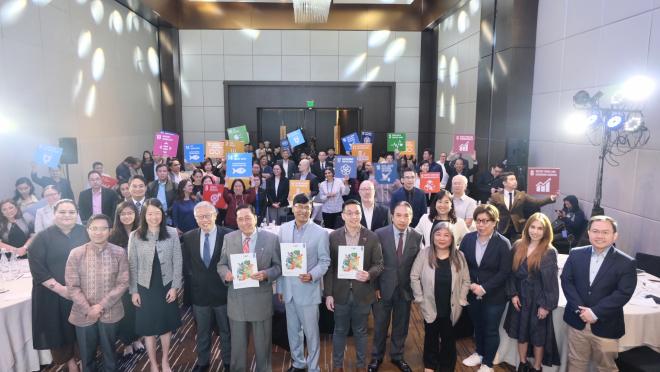The Philippines is one of the most dynamic economies in the East Asia and Pacific region. With increasing urbanization, a growing middle class, and a large and young population, the Philippines’ economic dynamism is rooted in strong consumer demand supported by a vibrant labour market and robust remittances. The private sector remains buoyant, with positive performance from the services sector including business process outsourcing, wholesale and retail trade, real estate, and tourism. The poverty rate declined from 23.3 per cent in 2015 to 18.1 per cent in 2021 despite the shocks endured through the COVID-19 pandemic and other global headwinds such as high global commodity prices and tight global financial conditions. The Philippine government pursues larger investments in both human and physical capital to boost growth over the medium and long term.
The Philippines’ economic recovery is well underway, as growth increased to 7.6 per cent in 2022 from 5.7 per cent in 2021. Real GDP growth is expected to bounce back in the second half of 2023 and reach 6 per cent in 2024, supported by an acceleration in public investment and improved external demand for the Philippines’ exports. The government’s infrastructure program, opening up of sectors to greater foreign investment, and private sector participation through PPP modalities will gradually crowd in private investment and help realize a growth potential of about 6 to 6.5 per cent over the medium term. Inflation is projected to gradually approach the target in early 2024, though recurrent supply shocks cloud the disinflation trajectory. The current account deficit is expected to continue to narrow in 2024. Risks to the growth outlook are tilted to the downside, mainly stemming from persistently high inflation, globally and locally, and a highly uncertain global economic and geopolitical environment. Upside risks to the inflation outlook include higher commodity prices and potential second-round effects.
The IMF’s Article IV consultation for 2023 points to sustained efforts to reduce infrastructure and education gaps and to harness the digital economy are needed to reap the benefits of the demographic dividend. They stressed the importance of strengthening governance and improving the ease of doing business. Directors also underscored that creating quality jobs and further enhancing education and social protection programs would help reduce poverty and inequality. They encouraged efforts to build resilience to natural disasters and climate risks, including by prioritizing climate-resilient infrastructure.
Over the medium term, the growth outlook will continue to be supported by strong domestic demand, driven by a robust labour market, continued public investments, and the positive effects of recent investment policy reforms which could boost private investment. With continued recovery and reform efforts, the country is getting back on track on its way from a lower middle-income country with a gross national income per capita of USD 3,950 in 2023 to an upper middle-income country (per capita income range of USD 4,466 -USD13,845).
Sources: Philippines: 2023 Article IV consultation- Press Release; Staff Report; and Statement by the Executive Director for the Philippines & The World Bank overview for the Philippines
12



Infrastructure, Health Care, Renewable Resources and Alternative Energy
0.699
How is this information gathered?
SDG Investor Maps employ an 8-step methodology, combining data research and stakeholder consultations to identify Investment Opportunity Areas (IOAs) and potential business models with significant financial and impact potential.
Disclaimer
UNDP, the Private Finance for the SDGs, and their affiliates (collectively “UNDP”) do not seek or solicit investment for programmes, projects, or opportunities described on this site (collectively “Programmes”) or any other Programmes, and nothing on this page should constitute a solicitation for investment. The actors listed on this site are not partners of UNDP, and their inclusion should not be construed as an endorsement or recommendation by UNDP for any relationship or investment.
The descriptions on this page are provided for informational purposes only. Only companies and enterprises that appear under the case study tab have been validated and vetted through UNDP programmes such as the Growth Stage Impact Ventures (GSIV), Business Call to Action (BCtA), or through other UN agencies. Even then, under no circumstances should their appearance on this website be construed as an endorsement for any relationship or investment. UNDP assumes no liability for investment losses directly or indirectly resulting from recommendations made, implied, or inferred by its research. Likewise, UNDP assumes no claim to investment gains directly or indirectly resulting from trading profits, investment management, or advisory fees obtained by following investment recommendations made, implied, or inferred by its research.
Investment involves risk, and all investments should be made with the supervision of a professional investment manager or advisor. The materials on the website are not an offer to sell or a solicitation of an offer to buy any investment, security, or commodity, nor shall any security be offered or sold to any person, in any jurisdiction in which such offer would be unlawful under the securities laws of such jurisdiction.




















